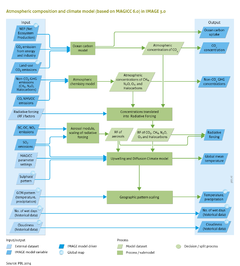Atmospheric composition and climate/Policy issues: Difference between revisions
Jump to navigation
Jump to search
No edit summary |
No edit summary |
||
| Line 1: | Line 1: | ||
{{ComponentPolicyIssueTemplate | {{ComponentPolicyIssueTemplate | ||
|Reference=Overmars et al. (unpublished); Van Vuuren and Stehfest, 2013; Shindell et al., 2012; | |Reference=Overmars et al. (unpublished); Van Vuuren and Stehfest, 2013; Shindell et al., 2012; | ||
|Description=Baseline developments: In baseline scenarios, emissions and greenhouse gas concentrations increase substantially. The increase in emissions depends on socio-economic factors, such as population growth, economic growth, technology development and lifestyle. Most medium baseline scenarios in IMAGE result in a rise in global mean temperature of about 3 to 5 °C above pre-industrial levels by 2100 (see figure below). | |Description=Baseline developments: In baseline scenarios, emissions and greenhouse gas concentrations increase substantially. The increase in emissions depends on socio-economic factors, such as population growth, economic growth, technology development and lifestyle. Most medium baseline scenarios in IMAGE result in a rise in global mean temperature of about 3 to 5 °C above pre-industrial levels by 2100 (see figure below **Figures zijn nog anders dan in chapter). | ||
|Example=Policy interventions that affect future climate range from policy on energy and agricultural systems, air pollution measures, and land-use policies to direct management of radiative forcing. For instance, the IMAGE system can be used to analyse energy efficiency, use of low-carbon fuels, reduction in non-CO2 greenhouse gas emissions and reduction of deforestation ([[Overmars et al. (unpublished)]]). Interventions related to policies on climate, air pollution and land use are described in [[Climate policy]], [[Air pollution and energy policies]] and [[Land and biodiversity policies]]. These measures lead to a change in emissions, and then to the expected reduction in radiative forcing and climate change. | |Example=Policy interventions that affect future climate range from policy on energy and agricultural systems, air pollution measures, and land-use policies to direct management of radiative forcing. For instance, the IMAGE system can be used to analyse energy efficiency, use of low-carbon fuels, reduction in non-CO2 greenhouse gas emissions and reduction of deforestation ([[Overmars et al. (unpublished)]]). Interventions related to policies on climate, air pollution and land use are described in [[Climate policy]], [[Air pollution and energy policies]] and [[Land and biodiversity policies]]. These measures lead to a change in emissions, and then to the expected reduction in radiative forcing and climate change. | ||
| Line 11: | Line 11: | ||
In addition to conventional climate policy, some situations may require urgent action on climate change, either rapid mitigation or solar radiation management (SRM) such as sulphur emissions to the stratosphere. Radiative forcing is immediately stabilised at the intended level by SRM, and temperatures are also adjusted immediately (though not yet at equilibrium level), and even faster under extreme SRM than would be possible through strong mitigation. However, substantial uncertainties and risks are related to such drastic manipulations of the radiation balance. | In addition to conventional climate policy, some situations may require urgent action on climate change, either rapid mitigation or solar radiation management (SRM) such as sulphur emissions to the stratosphere. Radiative forcing is immediately stabilised at the intended level by SRM, and temperatures are also adjusted immediately (though not yet at equilibrium level), and even faster under extreme SRM than would be possible through strong mitigation. However, substantial uncertainties and risks are related to such drastic manipulations of the radiation balance. | ||
}} | }} | ||
Revision as of 17:02, 10 February 2014
Parts of Atmospheric composition and climate/Policy issues
| Component is implemented in: |
|
| Related IMAGE components |
| Projects/Applications |
| Models/Databases |
| Key publications |
| References |
